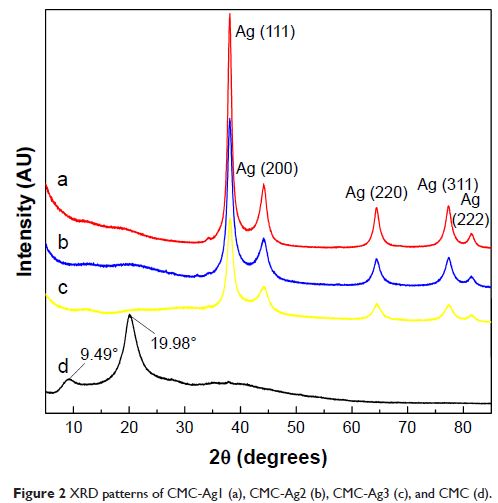9 5 7 4 9
论文已发表
注册即可获取德孚的最新动态
IF 收录期刊
- 3.3 Breast Cancer (Dove Med Press)
- 3.4 Clin Epidemiol
- 2.5 Cancer Manag Res
- 2.9 Infect Drug Resist
- 3.5 Clin Interv Aging
- 4.7 Drug Des Dev Ther
- 2.7 Int J Chronic Obstr
- 6.6 Int J Nanomed
- 2.5 Int J Women's Health
- 2.5 Neuropsych Dis Treat
- 2.7 OncoTargets Ther
- 2.0 Patient Prefer Adher
- 2.3 Ther Clin Risk Manag
- 2.5 J Pain Res
- 2.8 Diabet Metab Synd Ob
- 2.8 Psychol Res Behav Ma
- 3.0 Nat Sci Sleep
- 1.8 Pharmgenomics Pers Med
- 2.7 Risk Manag Healthc Policy
- 4.2 J Inflamm Res
- 2.1 Int J Gen Med
- 4.2 J Hepatocell Carcinoma
- 3.7 J Asthma Allergy
- 1.9 Clin Cosmet Investig Dermatol
- 2.7 J Multidiscip Healthc

抗菌性羧甲基壳聚糖 - 纳米银混合物的原位绿色合成与银的控制释放相融合
Authors Huang S, Yu Z, Zhang Y, Qi C, Zhang S
Received 16 December 2016
Accepted for publication 23 February 2017
Published 18 April 2017 Volume 2017:12 Pages 3181—3191
DOI https://doi.org/10.2147/IJN.S130397
Checked for plagiarism Yes
Review by Single-blind
Peer reviewers approved by Dr Thiruganesh Ramasamy
Peer reviewer comments 2
Editor who approved publication: Dr Linlin Sun
Abstract: In order to fabricate antimicrobial carboxymethyl chitosan–nanosilver
(CMC-Ag) hybrids with controlled silver release, this study demonstrated
comparable formation via three synthetic protocols: 1) carboxymethyl chitosan
(CMC) and glucose (adding glucose after AgNO3), 2) CMC and
glucose (adding glucose before AgNO3), and 3) CMC
only. Under principles of green chemistry, the synthesis was conducted in an
aqueous medium exposed to microwave irradiation for 10 minutes with nontoxic
chemicals. The structure and formation mechanisms of the three CMC-Ag hybrids
were explored using X-ray diffraction, ultraviolet-visible spectroscopy,
transmission electron microscopy, and Fourier-transform infrared analyses.
Additionally, antimicrobial activity and in vitro silver release of the three
synthesized hybrids were investigated in detail. The results revealed that a
large number of stable, uniform, and small silver nanoparticles (AgNPs) were
synthesized in situ on CMC chains via protocol 1. AgNPs were well dispersed
with narrow size distribution in the range of 6–20 nm, with mean diameter only
12.22±2.57 nm. The addition of glucose resulted in greater AgNP synthesis. The
order of addition of glucose and AgNO3 significantly affected particle size
and size distribution of AgNPs. Compared to CMC alone and commercially
available AgNPs, the antimicrobial activities of three hybrids were
significantly improved. Of the three hybrids, CMC-Ag1 synthesized via protocol
1 exhibited better antimicrobial activity than CMC-Ag2 and CMC-Ag3, and showed
more effective inhibition of Staphylococcus aureus than Escherichia coli . Due to strong
coordination and electrostatic interactions between CMC and silver and good
steric protection provided by CMC, CMC-Ag1 displayed stable and continuous
silver release and better performance in retaining silver for prolonged periods
than CMC-Ag2 and CMC-Ag3.
Keywords: carboxymethyl chitosan/nanosilver
hybrids, green synthesis, formation mechanism, controlled silver release, antimicrobial
effect
